A recipe, love and hate note, and journey
Makes about 3 cups of Sauerkraut with liquids drained | 6-8 weeks fermentation time
Fermentation is an emotional rollercoaster. One minute you think your fermentation baby is dying from mold and the next you think you’ve successfully achieved the hardest thing known to humankind–controlling bacteria to your will. But regardless, with each attempt you will continue to learn and refine, trusting your instincts along the way.
The steadfast rules of fermentation are as follows:
- Cover your ingredients with enough liquid to prevent oxygen from coming into contact.
- Ensure that the pH is below 4.6 to prevent botulism growth.
- Trust your smell–if it smells rotten, it is rotten. If it smells like diarrhea, you’re gonna get diarrhea.
- Keep the fermentation in a dark place away from sunlight.
- Not all molds are harmful but when in doubt, throw it out.

The first time I had sauerkraut was from Aldi’s. They sell these affordable jars of “Deutsche Küche
German Style Sauerkraut” for around $2 USD in Southern California where I’m from and they are so delicious. My family and I realized that sauerkraut tastes exactly identical to pickled Chinese napa cabbage except made of regular cabbages. We started using them in all the same ways we use pickled napa cabbage: boiled with thinly sliced fatty lamb, stuffed into homemade pork dumplings, and stir fried with meat. Just thinking about the umami of the meat paired with the acidity of the napa cabbage makes makes my mouth water.
Traditionally, Chinese napa cabbage is pickled whole during the winter months, stored away in a big urn and buried underground. The urn would be dug up once the snow melts and in the cold winter/spring months the family would enjoy delicious stews made with the pickles. My family did a similar thing but without burying and it was one of my favorite memories. We had a huge rock we forged which we lovingly called the “pickling rock” that was carefully washed and used to push down the cabbage so that it was fully submerged under water to prevent bacteria and mold growth.
As I got older and moved to North California, I still wanted to recreate those memories. We don’t have Aldi’s in NorCal because everything is so darn expensive so I thought this was the perfect chance to try my hand at making it myself. I thought to myself that I had fermented kimchi a thousand times I could do it in my sleep how hard could sauerkraut be? And boy was I wrong. It was a roller coaster.
Kimchi is usually only fermented for no more than 2-4 days depending on the weather and ingredients. In warmer weather and with more sugar content, kimchi ferments a lot faster. The softer the ingredients the faster it ferments. For example, napa cabbage and ramps ferment a lot faster than radishes.
But sauerkraut ferments for 6-8 weeks. That’s 6-8 weeks of hooing and haaing over whether this entire batch of ingredients and effort will be wasted. 6-8 weeks of staring at the carbon dioxide bubbles forming, opening the lid to sniff and struggle to place a flavor to the smell, and reassuring yourself you won’t die from eating this fermentation creation. So ladies and gentlemen, onto the recipe/adventure you will embark.
This recipe calls for very simple ingredients: filtered water, napa cabbage, salt and simple tools: 1 big airtight plastic or glass container and 1 heavy item to weigh down the cabbage. I used a plastic ziploc bag filled with water. Chinese recipes for pickling usually keep the entire cabbage in tact while German sauerkraut recipes thinly slice the cabbage. Both methods work but there are pros and cons. Cutting the cabbage decreases the salting time, reduces the size of the container you need because you can pack in more cabbage, and shortens the fermentation time. Keeping the cabbage in tact will be much easier to prevent mold and bacteria growth because little pieces of cabbage won’t float around at the top of the water. With napa cabbage you can even cut it into lengthwise quarters and keep the end intact as a compromise for pros and cons. I thinly sliced the cabbage in this recipe but you can do what feels best to you.
Ingredients
- 1 head of napa cabbage, about 3-4 lbs
- 1/3 cup fine sea salt (not iodized salt which will prevent fermentation)
- filtered water
Steps
Wash the napa cabbage and rip it into half then into quarters. Do this by first making a cut at the end of the cabbage and then with your hands rip lengthwise. Then thinly slice the cabbage into 1 inch strips.
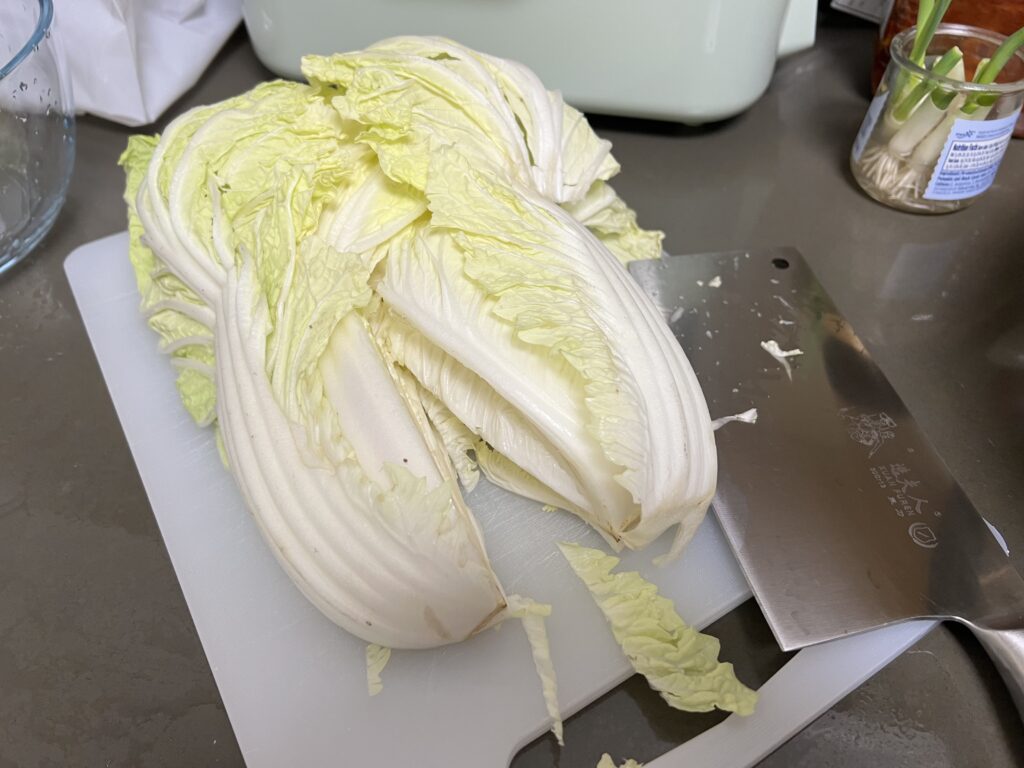
Put the cabbage into a large bowl and add the salt. Rub the salt thoroughly onto all the cabbage leaves. Let it sit for a total of 1 hour, mixing it after 30 minutes.
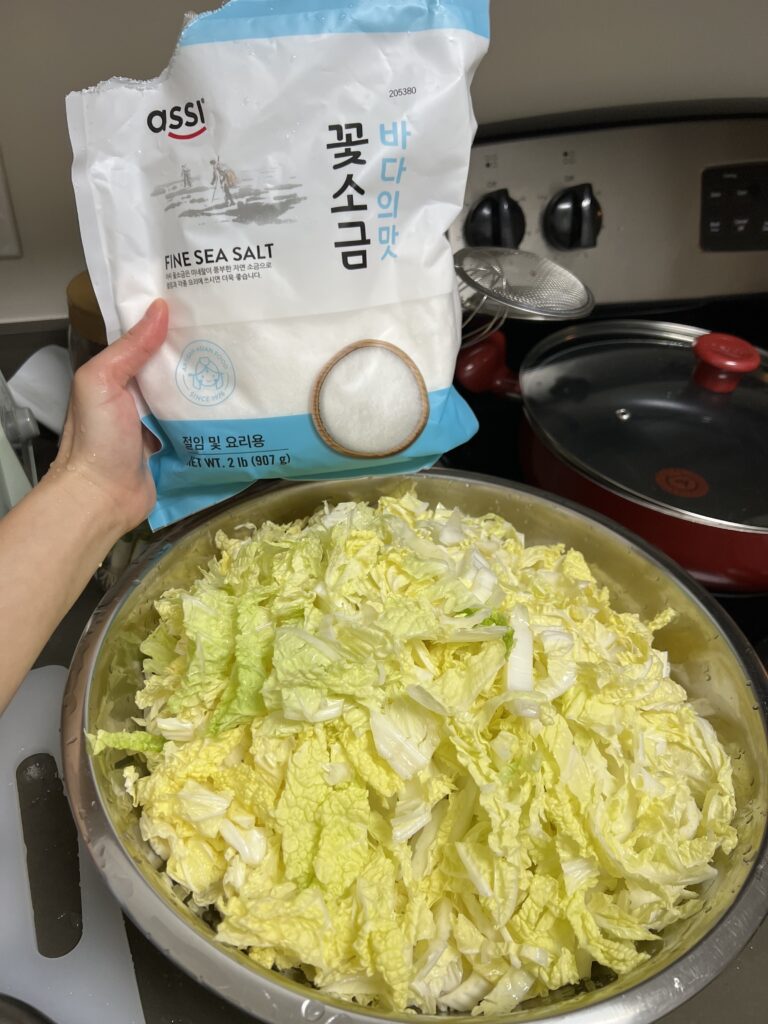
The cabbage should’ve wilted and released a lot of liquid. Rinse off the cabbage with fresh water.

In a very clean airtight container (about 120oz or 1 gallon container) add all of the pickled cabbage. Press the cabbage firmly into the container.
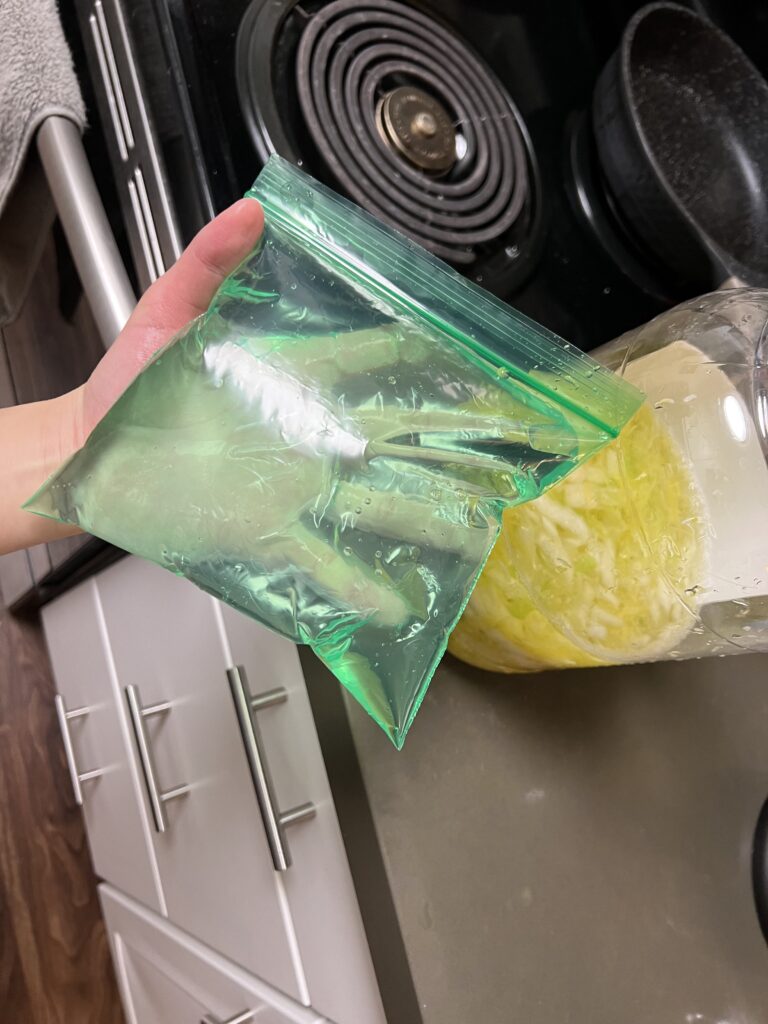
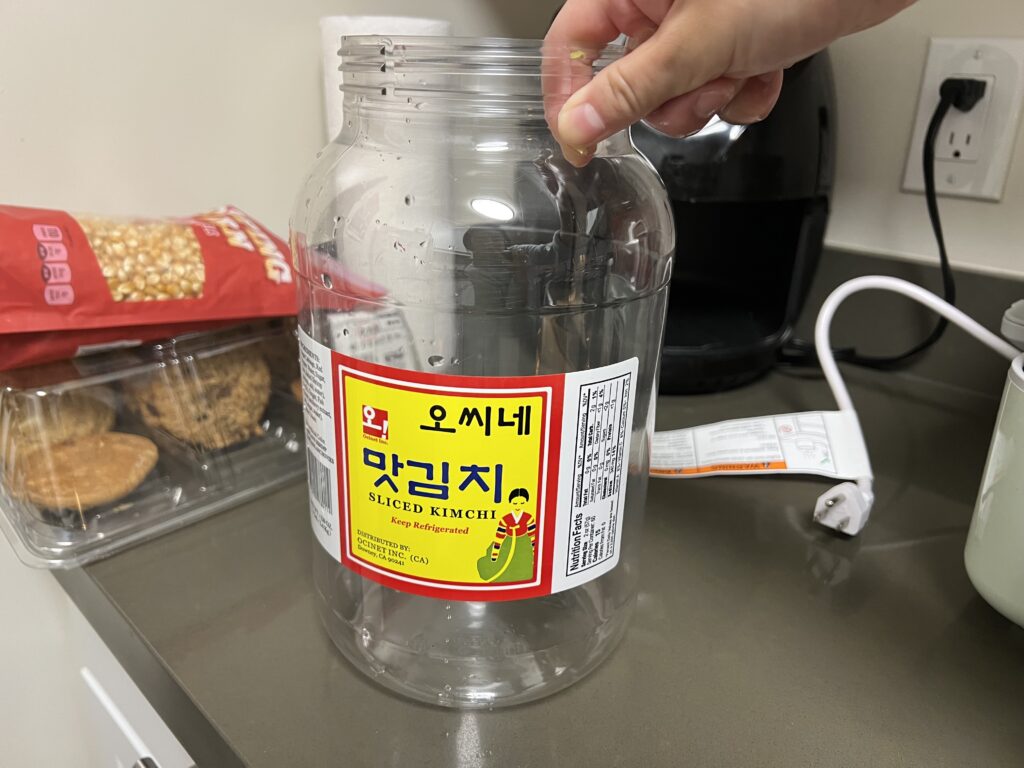
Add the sandwich bag filled with water to press down the cabbage. Add water into the container gently, enough to cover the cabbage and most of the bag. There should be at least 2 inches left in the container to prevent any overflow.
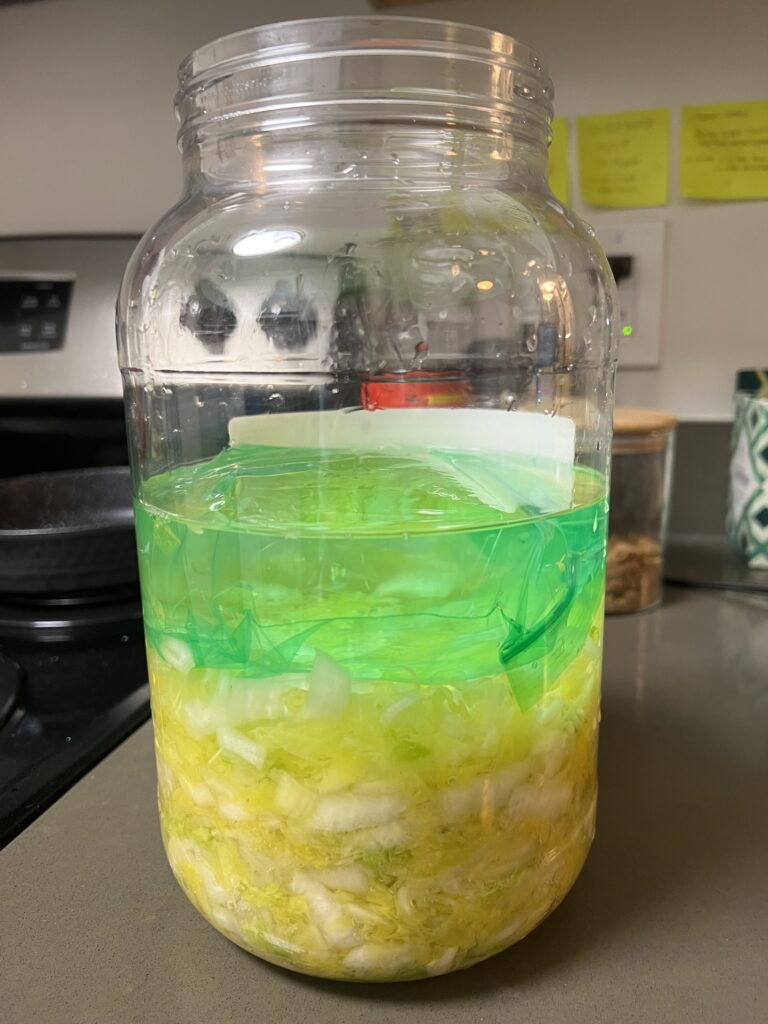
Make sure to remove any cabbage on the sides of the container exposed to air. These will induce mold growth. Cover the lid tightly and place the container in a cool and dark place between 65-70 degrees F. This is the ideal temperature range for fermentation.
After each week, check on the sauerkraut.
- The color should be pale yellow, any brown colors mean it is oxidizing from oxygen exposure. Decrease the time the lid is opened.
- The water should be covering all the sauerkraut. If it needs more water, add 1/2 cup water mixed with 1 tsp of salt.
- The smell should be pleasantly acidic. If it smells like alcohol or something nasty it has gone bad.
- There should be no visible signs of mold.
- The pickling water should be lightly yellow and mostly transparent. Not milky.
- Remove a small sample of the pickling liquid from the container. Using a pH meter, make sure that the pH is at least 4.6.
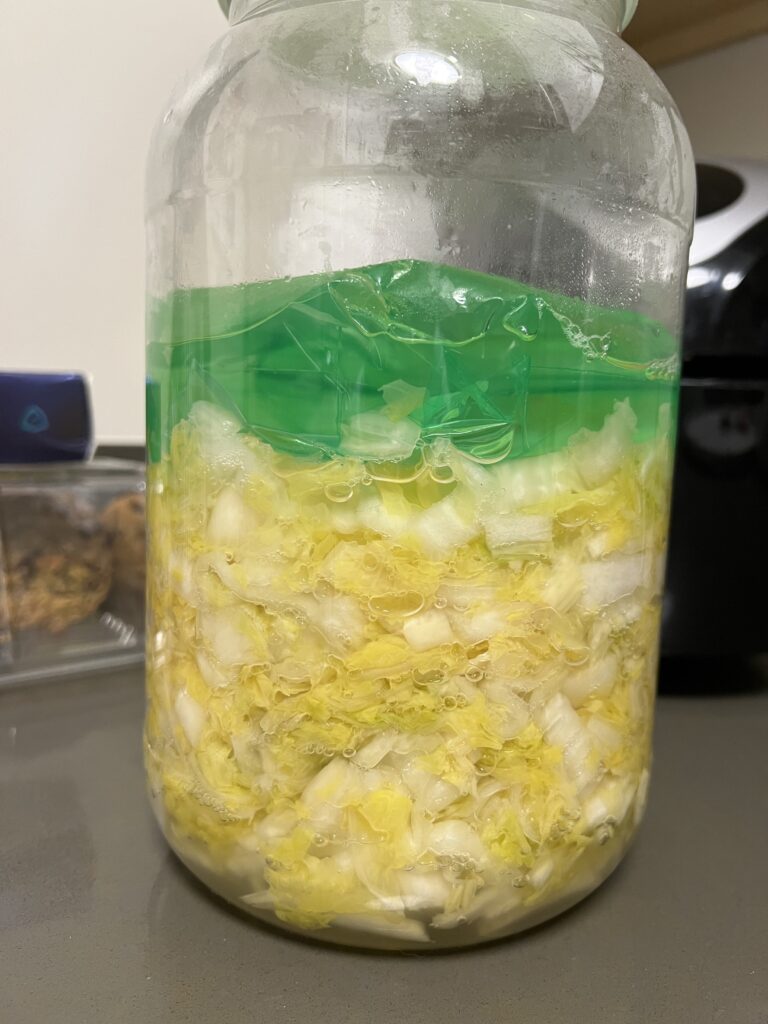
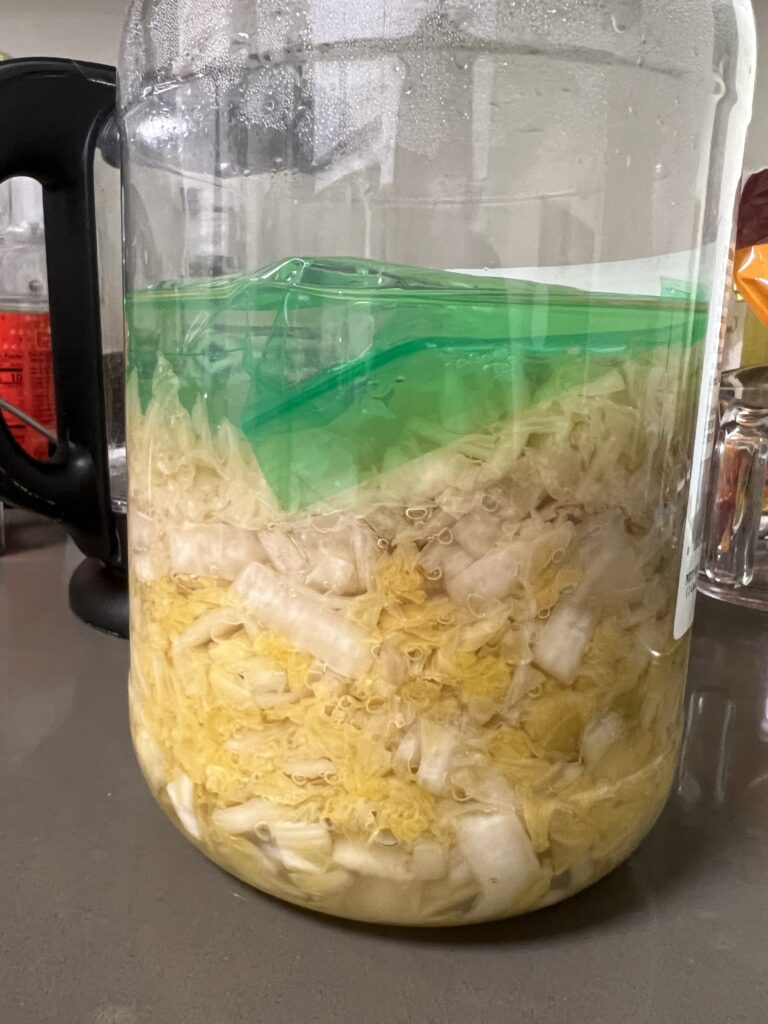
After 6-8 weeks check that the sauerkraut is pickled to your liking, place it in the fridge and enjoy. If you’re worried botulism it is best to cook it before consuming to kill the bacteria. See this delicious sauerkraut dumpling recipe for inspiration on how to use the sauerkraut!

